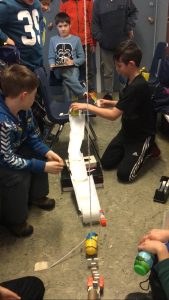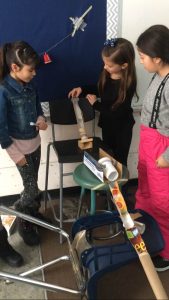Why Failure is Good by Mrs. Hulme
February 17, 2017 - 5 minutes readWhen my students are visibly frustrated during a task, my usual instincts are to comfort them and offer consoling words of advice. However, last week I found myself taking a step back and just observing a group of students “failing” at a particular task. Our inquiry into simple machines as devices that transfer force and energy prompted us to look at Rube Goldberg machines. The students were given a challenge to build a contraption that performs a very simple task. One step triggers the next in a chain reaction until the final task is complete.
After watching several videos – some created by students their own age – the first step was to design a plan for their own machine. Individually, they drew and labelled diagrams of machines completing a task using simple household materials. The next day, I put them into groups and they shared their plans and were asked to create one group plan using elements from each of their designs. They had 3 afternoons to build and test their contraptions. On day one, groups mostly gathered materials, taped paper towel rolls together and solidified what their simple task was going to be. The students went deep into building their machines on day two. Some groups even began testing their product, made chan ges and tested again. It was this day that I observed all groups fail at executing their simple task.
ges and tested again. It was this day that I observed all groups fail at executing their simple task.
It wasn’t as difficult as I thought it would be for me to withhold input on improvements to their designs. One student in particular was on the verge of tears because he couldn’t get a ball to tip a bottle, which would then ideally hitanother ball into a cup on the floor. He tried many times to alter pieces and adjust timing but at the end of the class, his group was unsuccessful. On day three, all groups came together and collab orated to incorporate new changes. Some groups started fresh and designed and tested new prototypes. I was nervous for the group that had the emotional and frustrated student, as I was not sure they could take another day of failure. I filmed a few of their first attempts – all of which were unsuccessful. After each trial they spent time altering and adjusting again and would call me over to film their next attempt. This was followed by more unsuccessful efforts. Finally, I watched each chain reaction lead to the next through the screen of my iPhone and it ended with the ball in the cup and the four students cheering in a celebratory embrace. The one student proudly exclaimed, “18 failures, and one success!” At the end of the day, all six of the group’s machines successfully completed a simple task. Witnessing the kind of tension that all of the students felt through this process ended up being a gratifying experience for me.
orated to incorporate new changes. Some groups started fresh and designed and tested new prototypes. I was nervous for the group that had the emotional and frustrated student, as I was not sure they could take another day of failure. I filmed a few of their first attempts – all of which were unsuccessful. After each trial they spent time altering and adjusting again and would call me over to film their next attempt. This was followed by more unsuccessful efforts. Finally, I watched each chain reaction lead to the next through the screen of my iPhone and it ended with the ball in the cup and the four students cheering in a celebratory embrace. The one student proudly exclaimed, “18 failures, and one success!” At the end of the day, all six of the group’s machines successfully completed a simple task. Witnessing the kind of tension that all of the students felt through this process ended up being a gratifying experience for me.
It’s strange to say that I wish my students experienced this feeling more often because then their overall success would be sweeter. I use the term “growth mindset” in my class daily, and this was a concrete example of how their ability to persevere and work effectively and collaboratively in a group contributed to a finished product they were proud of. Carol Dweck the author of the book, “Mindset”, believes that someone with a growth mindset embraces challenges due to a desire to learn and shows perseverance in the face of obstacles. Through this inquiry assignment, my students demonstrated these important growth-mindset values.
Not only were my students engaged in a scientific activity, but they were also engaged in Applied Design, Skills, and Technologies (ADST). This new component of the curriculum is one way for students to develop critical and creative thinking skills along with communication skills and personal/social skills.
Guest Blogger Christine Hulme teaches grade 4/5 and is a Head Teacher at Hollyburn.
Recent Comments